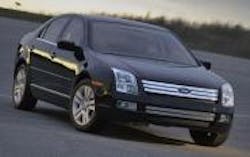“Intelligent vehicles are the next frontier of collision avoidance; [they] hold the potential of helping reduce many crashes.” –Sue Cischke, group vice president-sustainability, environment and safety engineering, Ford Motor Co.
It’s a concept that holds all sorts of promise: “intelligent vehicles” that can wirelessly “talk” with one another via Wi-Fi and using GPS to “tell” where they are located, helping reduce crashes and traffic congestion to boot.
Now, I’ve pondered this topic in a post before, concerning vehicle-to-vehicle (V2V) and vehicle-to-infrastructure (V2I) communication capabilities. But now it’s starting to become a reality, many OEMs starting to deploy such technologies in test vehicles.
Ford Motor Co. recently showed off what it called “functional prototypes” to preview these intelligent vehicle technologies, conducting a series of events nationwide in recent weeks to explore the real-life benefits and near-term feasibility of such systems in: San Francisco, Washington, DC, New York city, and Los Angeles.
Here’s how Ford's version of intelligent vehicle communication works. First, they “talk” wirelessly with one another using advanced Wi-Fi signals, or dedicated short-range communications, on a secured channel allocated by the Federal Communications Commission (FCC).
Unlike radar-based safety features, which identify hazards within a direct line of sight, the Wi-Fi-based radio system allows full-range, 360-degree detection of potentially dangerous situations, such as when a driver's vision is obstructed, according to Paul Mascarenas, vice president, Ford’s research and innovation division and the company’s chief technical officer.
[Here’s a short video showing how Ford is crafting “intelligent vehicle” systems.]
“For example, drivers could be alerted if their vehicle is on path to collide with another vehicle at an intersection, when a vehicle ahead stops or slows suddenly or when a traffic pattern changes on a busy highway,” he explained. “The systems also could warn drivers if there is a risk of collision when changing lanes, approaching a stationary or parked vehicle, or if another driver loses control.”
The safety benefits could be significant, according to research conducted by the National Highway Traffic Safety Administration (NHTSA) last year. Used as a primary countermeasure:
• V2V systems potentially address about 4,409,000 police-reported or 79% of all vehicle “target” crashes (those where drunk/drugged driving or fatigue are not involved), 81% of all light-vehicle target crashes, and 71% of all heavy-truck target crashes annually.
• V2I systems potentially address about 26% of all-vehicle target crashes, 27% of all light-vehicle target crashes, and 15% of all heavy-truck target crashes annually.
• Combined V2V and V2I systems potentially address about 81% of all-vehicle target crashes, 83% of all light-vehicle target crashes, and 72% of all heavy-truck target crashes annually.
“These safety applications … increase situational awareness and reduce or eliminate crashes through V2V and V2I data transmission that supports driver advisories, driver warnings, and vehicle and/or infrastructure controls,” NHTSA said.
"Intelligent vehicles could even help warn drivers of numerous potential dangers such as a car running a red light but blocked from the view of a driver properly entering the intersection,” Ford’s Mascarenas (seen at right) added.
Intelligent vehicles could also ease traffic delays by communicating with each other and infrastructure, such as traffic camera networks and traffic signals, to process real-time traffic and road information faster, allowing drivers to choose less congested routes.
There could be big savings here. According to Texas Transportation Institute's (TTI) 2010 Urban Mobility Report, traffic congestion continues to worsen in American cities of all sizes, annually wasting nearly 3.9 billion gallons of fuel in 2009. Using San Francisco as an example, Ford said the average commuter in that city spends an additional 49 hours spent sitting in traffic and wastes 39 gallons of gas costing $1,112 per driver due to idling in congestion.
“We are not far from the day when vehicles will operate like mobile devices with four wheels, constantly exchanging information and communicating with our environment to do things such as shorten commute times, improve fuel economy and generally help us more easily navigate life on the road,” Ford’s Mascarenas said.
Most importantly, Ford is partnering with other automakers and the federal government, as well as local and county road commissions, to create a “common language” that ensures all vehicles can talk to each other based on a common communication standard, he added
While there are challenges ahead, the foundation technologies for these “intelligent” vehicles already exist and in advanced forms, Mascarenas pointed out. That could potentially make equipping cars and trucks with such technology easier and cheaper than expected.
Obviously, we’re not quite there yet, but we’re getting closer. The final leap will be ensuring such systems don’t overload the driver’s sensory input – something that will only become clear as more tests are conducted.
